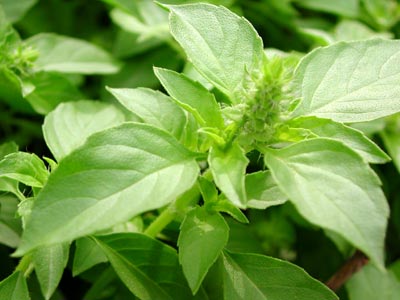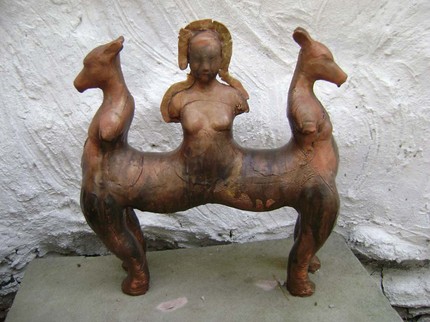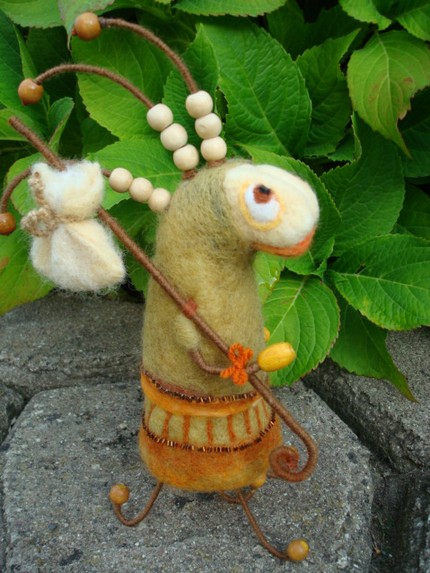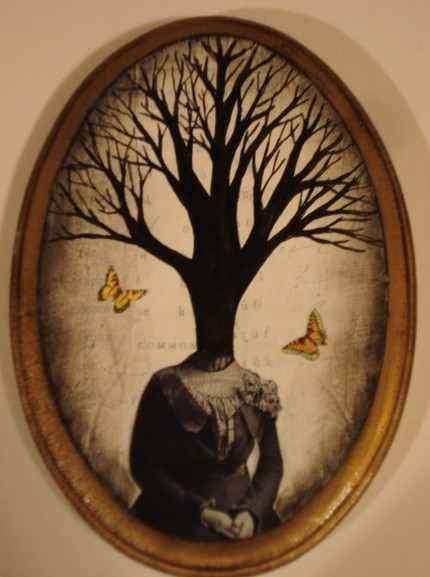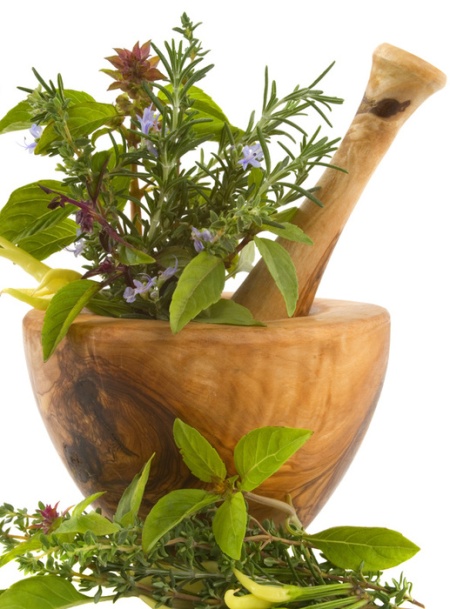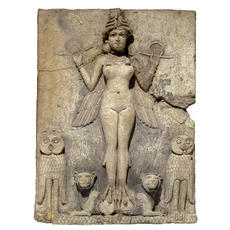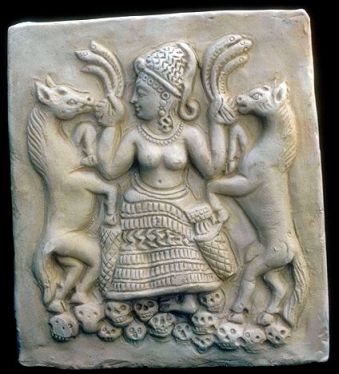A friend recently passed along a fabulous blog called BibliOdyssey, as well as a post with illustrated manuscript belonging to a 15th c. herbal text titled the Codex Sloane 4016. Like other early manuscripts focusing on herbs, these treatises documented accumulated knowledge about medicinal plants from the oral tradition. In the image above you will immediately recognize St. John’s Wort as the medieval “ypericon”, known now by the latin hypericum perforatum. With the myriad uses for the invaluable St. John’s Wort, SSRI action, anti-viral activity, and vulnerary for nervous system-related symptoms among them, what I did not know was that St John’s Wort was also considered a demon repellent. And what a cute little demon we have here in this medieval illustration, not unlike the many forms of hybrid creatures found on the column lintels that would have surrounded monastic herb gardens of that period. I am sure every monastery had its St. John’s Wort patch for this reason, among the many other uses. Do pop back to this post to see the other lovely illustrated manuscripts from the Codex, as well as information about its facsimile at the British Library and even more delightful tidbits from their blog. And while you are at it, this wonderful collection of downloadable manuscripts, the Codex (Tractatus de Herbis) among them. Ahhh, if I were to go back to working towards a PhD again….I’d be sorely tempted.
Why Lilith? The reason for the name behind the Apothecary.
February 9, 2012My name is not Lilith. As many of you know, dear readers and customers of my Apothecary, my name is Sarah. Though many people name their businesses after themselves, the reason for using the name Lilith is a bit convoluted, and I often get questions about it, so I will try to be articulate about my reasoning here.
Lilith first appeared in ancient Hebrew texts as a demon or a monster, but I am not concerned about those earliest references which are controversial in their authenticity at best. More interestingly, Lilith appears in the 8th–10th centuries in Jewish folklore as Adam’s first wife, created at the same time as Adam, and considered his equal, unlike Eve who was created from Adam’s rib. In the 13th Century mythology, Lilith left Adam after she refused to become subservient to him and then would not return to the Garden of Eden after she mated with the archangel, Samuel. Though Lilith is a name often used in reference to a feminine stance, I wanted to think deeper about this mythological figure and what she represents. The fact that she was Adam’s equal from the start rather than made to serve him, that she was fiercely independent, and strong in character certainly stand apart from the story of Eve. She took control of her own sexuality and copulated with an archangel, thereafter refusing to return to the Garden, which despite it’s earthly delights, was not quite up to par with sex with an archangel, I’m guessing. Call it a hunch.
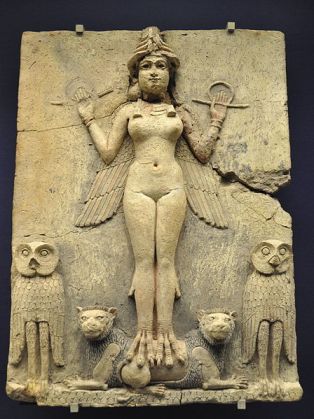 This is an Babylonian image that is often associated with Lilith and in my earliest labeling, I used this image on all of my products. Called the Burney Relief, Babylon (1800-1750 BCE), this figure is apparently based on a misreading of an outdated translation of the Epic of Gilgamesh, and modern research has identified the figure as either Ishtar or Ereshkigal. How perfect! The pairing of those two goddesses lends even more interest to the Lilith story, though the linkages may be only the red threads between them that exist in my mind. While they may not be related to Lilith, the Assyrian Ishtar (or Sumerian, Inanna) is the goddess of fertility, war, love, and sex. Even as the goddess of fertility, she was not as kind and benevolent as you might think, and she was above all the goddess of sexuality and could be brutal to her consorts and lovers. That said, she had many faces, just as we humans do, and in a famous legend about her decent to the Underworld. There, Ereshkigal, the goddess of the Underworld, allows her to enter but only according to the rules. She must shed her clothing as she passes through each of the seven gates. When she finally arrives, she is naked and in a rage! Ereshkigal puts her in prison and sends 60 diseases upon her, but eventually Ereshkigal is commanded by the gods to revive her by sprinkling her with the waters of life.
This is an Babylonian image that is often associated with Lilith and in my earliest labeling, I used this image on all of my products. Called the Burney Relief, Babylon (1800-1750 BCE), this figure is apparently based on a misreading of an outdated translation of the Epic of Gilgamesh, and modern research has identified the figure as either Ishtar or Ereshkigal. How perfect! The pairing of those two goddesses lends even more interest to the Lilith story, though the linkages may be only the red threads between them that exist in my mind. While they may not be related to Lilith, the Assyrian Ishtar (or Sumerian, Inanna) is the goddess of fertility, war, love, and sex. Even as the goddess of fertility, she was not as kind and benevolent as you might think, and she was above all the goddess of sexuality and could be brutal to her consorts and lovers. That said, she had many faces, just as we humans do, and in a famous legend about her decent to the Underworld. There, Ereshkigal, the goddess of the Underworld, allows her to enter but only according to the rules. She must shed her clothing as she passes through each of the seven gates. When she finally arrives, she is naked and in a rage! Ereshkigal puts her in prison and sends 60 diseases upon her, but eventually Ereshkigal is commanded by the gods to revive her by sprinkling her with the waters of life.
And why am I telling you all of this? Because this descent and revival is so intrinsic to our life on earth as human beings. First of all, we need to nurture the many sides of our characters, and those may include facets we are not encouraged to present to the world, at least as dictated by our modern societies. We are not ‘encouraged’, for women especially, to present our anger, frustration, our deepest sexuality, our moods if they are not sunny and bright. We are told to be Superhuman in our ability to stay bright and lively and committed to everything, even when we are burdened with difficulties, with family troubles, with work, or even with the fatigue of our intense, modern lifestyles. Ishtar’s story reminds us of the need to feel our rage, to allow that descent to the Underworld and our darkest places, even if that means a temporary, quiet withdrawal from social obligations. We need to be able to confront our own demons, to even be assaulted by the emotions we feel, and then to have the space to seek respite, to nurture ourselves back to life again, thus the ‘sprinkling of the waters of life’ for revival. But it is important to note that these darker aspects of our nature are not necessarily needing to be expunged — they are part of who we are, and these dark places also need to be accepted as part of our whole being. There is a fantastic Jungian analysis of this mythology that was quite formative in my thoughts about this mythology, and also in my own journey, allowing myself to feel and be respectful of the complexities of my inner world and deepest nature.
Bravery accompanies Her:
Ishtar the bold
Her festivals are the Warriors´ festivals,
The stimulation of the warriors at combat,
The rousing of officers
The liberation of armies
Her rage at combat,
Her enthusiasm in battle
Reveal Her true Nature
And demonstrate what Ishtar knows how to do!
So how does this all connect to me naming my business Lilith’s Apothecary? Well, quite simply it is a reminder to us all that we have every right to a firm footing in the world, that we have the ability to not only be equals with our peers, lovers, and mates, but that we can also allow the many parts of ourselves (those deep, hidden, or even dark places included) to exist in harmony and balance. Using herbs, our plant allies, to nurture our deeper selves is just one piece of this need to attend to ourselves more fully. In my small way, and despite more limited means than the large corporations we have come to know so well, I want to help provide men and women with the ability fulfill this important function with natural, raw ingredients — minerals such as clay and mica; gifts from the animal kingdom like milk, yoghurt and honey; and oils, essential oils, and raw herb matter to nourish ourselves both inside and out. With these materials from the earth, we are able to nudge our bodies into balance, hopefully. Above all, the herbalist is concerned with helping a person achieve holistic balance, and thus it is also my primary motivation. By looking at the full person, we can help try to ascertain what needs should be met, and hopefully what we can suggest as helpful assistance, ideas, and suggestions for achieving that equilibrium that we all seek.
I do hope all of that makes sense. You’ll be happy to know that my new website, complete with herb consulting details, is only now waiting for me to tweak a few things and then it will be live very soon. If you have any comments, stories, or feedback, I would love to hear from you. xo ~ Sarah
Incidentally, you may be interested in my Ishtar blend, named for this very story and with the achievement of hormonal and emotional balance in mind. I just ordered some organic shatavari root so I can make you a custom blend if you would like to try it.
Top 50 Blogs for Learning about Herbalism
August 2, 2010 Yeah for me! Lilith’s Apothecary ~ this blog ~ was recently listed as one of the Top 50 Blogs for Learning about Herbalism, much to my delight. The blogger, Rachel Davis, divides her list of blogs up into categories of 1) General, 2) Farming, 3) Herbalists, 4) Herbalism & More, 5) cooking, 6) Medicine. The final category of blogs is where my own appears. There are lots of great blogs to check out on this list, and some great new discoveries for me include:
Yeah for me! Lilith’s Apothecary ~ this blog ~ was recently listed as one of the Top 50 Blogs for Learning about Herbalism, much to my delight. The blogger, Rachel Davis, divides her list of blogs up into categories of 1) General, 2) Farming, 3) Herbalists, 4) Herbalism & More, 5) cooking, 6) Medicine. The final category of blogs is where my own appears. There are lots of great blogs to check out on this list, and some great new discoveries for me include:
1. The Herbwife’s Kitchen, a blog written by a traditional Appalachian community herbalist based in West Virginia
2. Herbs from the Labyrinth, a blog from a community herbalist out in Lancaster, PA, about an hour outside of Philadelphia.
3. Rosemary’s Sampler, a lovely blog from The Rosemary House, a charming establishment in Mechanicsburg, PA, and a place I’ve been wanting to go for years. They often have great little workshops and herbwalks with well-known herbalists such as David Winston.
4. The Medicine Women Gather: five herbalists from the Pacific NW gather to share recipes, wildcrafting, and the gifts of the earth.
5. Joseph Alban: an acupuncturist in NY who teaches us acupressure points to use for ourselves and our children, as well as other info about chinese herbs, etc.
Share some of your favorite herb-themed blogs with me! I’ll write a future post on some of the most useful herb blogs, including those by Michael Tierra & Leslie Tierra, Stephen Foster, and other master herbalists. Michael Tierra just blogged about Richo Cech, a “plant whisperer” and author of The Medicinal Plant Grower.
Holy Basil: the Divine herb for 2010
January 7, 2010Ocimum sanctum. The very name seems hallowed and sacred somehow., don’t you think? Well, Tulsi, or Holy Basil, gets my vote for the numero uno herb for 2010. After 2009, we all need it! But you judge for yourself.
From the Lamiaceae family, and called Tulsi (Hindi), surasa (Sanskrit), and sacred or holy basil, this wonderful herb has so much to offer us. A prized medicinal in Ayurveda, the 5,000 year old traditional medical system of India, we are all fortunate that holy basil has now found its way into the Western herbal reperatoire. And how can it be ignored? It’s an adaptogen, antibacterial, antidepressant, antioxidant, antiviral, carminative, diuretic, expectorant, galactagogue (promotes the flow of mother’s milk), and immunomodulator. But those are scientific terms to describe what Ayurveda has been attesting for perhaps 3,000 years: namely that this herb is a rasayana, a herb that nourishes a person’s growth to perfect health and promotes long life.
Tulsi’s uses in Ayurvedic history are myriad. Sacred to the Hindu god, Vishnu, holy basil is used in morning prayers in India to insure personal health, spiritual purity, and family well-being. Beads made from the tightly rolled plant stems are used in meditation for clarity and protection. The daily use of this herb is thought to support the balance of chakras (energy centers) of the body. It is thought to possess sattva (energy of purity) and as being capable of bringing on goodness, virtue, and joy in humans.
In terms of application to bodily disharmony or dis-ease, holy basil has many uses, including for nasal congestion, as an expectorant for bronchial infections, for upset stomach, for digestive issues, for soothing the urinary tract when urination is difficult and painful, and even to lower malarial fevers. Today this versatile plant is primarily seen as an adaptogen with antioxidant, neuroprotective, stress reducing, and radioprotective effects. It has also been shown to lower blood sugar levels, and can be a useful adjunct therapy for a diabetic. One of the primary reasons why I love the herb are for its stress reducing, anti-depressive effects. Clinical studies have shown significant anti-stress activity when the herb is taken as an alcohol extract, as it seems to prevent increased corticosterone levels that indicate elevated stress.
Holy Basil is used to enhance cerebral circulation and memory, even to help alleviate the “mental fog” caused by chronic cannabis smoking. David Winston also advocates the use of Holy Basil in situations of ‘stagnant depression’, a classification of depression that he coined to describe a type of situational depression. As he describes it, “In this case, some type of traumatic event occurred in a person’s life, and because he is unable to move on, his live comes to revolve around the trauma. In addition to therapy, herbs such as holy basil, damiana, rosemary, and lavender are especially useful for treating this condition” (Winston & Maimes 2007).
Tulsi is an adaptogen that helps the body alleviate stress, but certainly at the time of a traumatic event, and will also help lift spirits, provide clarity when it is most needed, and hopefully help prevent the formation of the stagnant depression as described above. There’s no question that in simplest terms, an herbal tea made with holy basil, rose petals, lavender, and perhaps a few other nutritive herbs would be a wonderful blend for someone recovering from loss. For long term therapeutic use, however, tincture form is probably preferred.
Tincture: 40-100 drops 3 x a day
Tea: Add 1 tsp dried leaf to 8 oz hot water, steep, covered, 5-10 min. Take 4 oz up to 3 x a day.
Safety Issues: There have been contradictory animal studies showing that holy basil might be toxic to embryos. Until conclusive information exists, avoid using it during pregnancy. Holy Basil is also reported to have an antifertility effect and should be avoided if a woman is trying to get pregnant. It is perfect for after birth, however, as it helps increase milk production.
Drug Interactions: Preliminary studies indicate that holy basil might enhance CYP-450 activity, thus speeding up the elimination of some medications.
I prefer making a tincture from the fresh herb, which I purchase from Pacific Botanicals, an organic herb farm in Oregon. You can buy the dried herb from Pacific Botanicals, Mountain Rose Herbs, and other reputable companies. However, make sure the herb is green and aromatic, whether dried or fresh. You can purchase the tincture from me via Etsy or from Herbalist & Alchemist.
REF: Winston, David and Steven Maimes (2007) Adaptogens: Herbs for Strength, Stamina, and Stress Relief. Rochester, VT: Healing Arts Press
Looking for something unique? One of a kind art
December 5, 2009One of a kind fiber arts are not something I set out to find, but somehow (and I’m not sure exactly how), I came upon this amazing artisan, Robin E. Whiteman of Clayrew (etsy), who makes unique, one of a kind fiber art pieces, such as this lovely rendition of Lilith with her animal familiar, the owl. Lilith, the inspiration for my business, has a magical aura about her, just as Robin’s artworks do. I wanted to share her work with my readers, as this time of year I tend to blog a bit more about amazing material finds and one of a kind wonders. Robin’s pieces include fiber and ceramic sculptures seemingly drawn from Jungian psychology, the archaeology of Marija Gambutas, who pioneered the concept of goddess religions pre-dating patriarchal religions and culture in human history, bits of human artifact (such as leather from crete) and her own intuitively creative inspiration and sculptural musings.
For instance, the Fetish 1 piece, pictured here, is at first glace a representation of fetishes favored by paleolithic and early neolithic cultures, but a closer examination reveals a face emerging from the belly of the female form, a surprising revelation that lends further mystery to the piece.
I also love her ceramic Dark Goddess, a piece that I would love to have in my fantasy home, one with hallways with quiet niches where such pieces could be properly and reverantly placed. The Dark Goddess is coated in bronze encaustic wax, a material favored by Jasper Johns that has always fascinated me as a material I would love to work with. Encaustic provides a textural effect that adds another dimension to two-dimensional art, such as many of Johns’ paintings. In this piece, the bronze encaustic on ceramic provides a sense of ‘the ancient’ (that ellusive, undefinable ‘ancient’ that we can’t even really pinpoint except in the minds of Jung and in the texts of myth) that gives it the not-quite-tangible aura of an artifact of an ancient goddess religion. Just the kind of chills I love to get from a material object. Maybe this is why I married an archaeologist. Hmmmm
Winter Spirit…The Gift Guide
November 13, 2009
The autumn already seems to be ebbing away, though there are still a few wee tomatoes on my urban-dwelling vines. Still, many of autumn’s bright and colored leaves have fallen. Though I don’t usually create a treasury of beloved handcrafteds for this most herby of blogs, I was perusing through etsy favorites and felt inspired to share these lovelies with my dear readers. You may not want to spend that much on a chandelier, but you must admit….it is amazing! And if that is out of your price range, you might invest in a wee felted grasshopper, such as this one created by Grazim, and etsy shop located somewhere in Europe, and also the home of the sweetest felted slippers you’ve ever seen.
The Peaceful Afternoon dress, and other poetic creations, can be found in sarahseven‘s etsy shop. One must pay for luminous handmade creations, but would we artisans have it any other way?
There are many beguiling images by The Haunted Hollow Tree etsy endeavor, but this one demands a frame and prized wall space at my humble abode.
Alma Pottery claims to have art + attitude in the shop’s clever creations. I think this absolutely bizarre-fairytale-meets-the-surreal Mutant Bunny mask certainly fulfills the claim. I love it!
Well, this is that (albeit *slightly pricy*) chandelier by Fiko Art I was talking about. I wish I lived in a house that could handle it! Maybe a converted one-room schoolhouse? Well, you’d need some lofty ceilings for this magical centerpiece. Take note of the absolutely amazing details, including the carving. This is an absolute work of art, and probably museum quality as well.
I find terrariums absolutely enchanting, I have to say. I recently made a few without reading any directions as to the actual process (duh) and needless to say they didn’t work out that well. The keys are 1) not letting the moss touch the glass (fog), and 2) using charcoal to absorb moisture and also making sure there is some rocks at the bottom for a bit better ‘drainage’. Next time I’ll get it right! But in the meantime, check out Doodle Birdie for some lovely creations.
Ok, so let me send a subtle message into the ether. *I want this necklace for Christmas* Too bad my husband doesn’t read my blog! Alas. But still, this has been a favorite since it first appeared on the scene, at least a year ago. After Winter’s proprietress makes these absolutely amazing molded pieces using nature + pure sterling silver to create the most gorgeous pieces of adornment. These are heirlooms.
I absolutely adore the vintage look to these handmade wool baby boots, complete with leather sole for those new walkers. I mean, I either have to buy these for some random baby I come across, or I need to have a new baby so I can shod its feet in these grey woolies. Either way – these booties must be worn by a baby that I know. Thank you Wooly Baby. Thank you for subtley pressuring me to have another baby so I can pay another $12,000 a year in child care costs.
Is this a save the best for last moment? I’m not sure, but I can say, from one Sarah to another, Sarah Ogren is one of my absolute favorite etsy sellers. I do often wear a necklace creation, not unlike this amazing image, but I adore all of her animal headed Victorian creations equally, and someday soon, I want one for my walls (or at least my three year old daughter’s bedroom, where it would be most precious). Hint, Hint.
You know, most etsy officianados like the lovely Scoutie Girl blog (thank you, Tara Gentile) create things called ‘Gift Guides’. Even etsy has its own Gift Guides to help overwhelmed and confused shoppers. I create Give-me-this Guides, apparently. I’m laughing out loud here because I’m not serious (but kinda am). I will say this. Nobody needs to buy me the Chandelier or the $500 frock, but…my three year old, Maeve, could try her hand at making a terrarium perhaps? Daddy? What’dya say?
Immune Boosting Herbs talk @ Holistic Moms Network meeting
October 7, 2009
Tonight I had the pleasure of presenting about the use of herbs to fight colds and flus, particularly with regard to the treatment of small children. The presentation was delivered to a local chapter of the Holistic Moms Network. It’s fun presenting to the choir, more or less, as this group is made up of parents who are interested in holistic health & living in all respects. And such a lovely group of people, dads and moms alike!
We were able to talk about the energetics of foods and herbs, the use of preventative versus acute herbal remedies, and dosages for small children & infants. I am again reminded of how wonderful it is to share knowledge and information about our botanical allies, and of course giving such talks only reinforces that for me. I was reading a bog post on ProBlogger this morning about weighing the cost-benefit of speaking at events for free. In other words, what’s in it for the business? For some people, attending a far away conference to speak without compensation means that they have to figure out why the trip would be worthwhile, whether through contacts, networking, or business sales. I definitely identify with that when I think about my ‘day job’ in Public Health. I also make decisions like that when it comes to my business, Lilith’s Apothecary. But when it comes to herbal medicine, if I can afford it, I am more than happy to participate in any way I can. It’s true that I do indeed have an herbal bath and body business of sorts, but I don’t educate about herbs because I want to sell products. In fact, I hardly even indicated that I have a business tonight. Instead, I want others to learn how to make the products for themselves! Sure, I can make it for you if you don’t have the time or desire (i.e. I can’t sew, so someone has to sew things for me!), but if you want to make your own herbal syrup, by all means! Let’s do it. And doing it together is so much fun.
Holistic Moms Network
NJ/Philadelphia Chapter
Collingswood, NJ
Thanks for having me!
Other posts that may be of interest:
What to do about H1N1: 5 Tips
Nervous About Swine Flu? Look to Herbal Medicine for Immune Boosting
DIY Remedies for the Cold Season Part I
DIY Remedies for the Cold Season Part II
Herbal Facial Steams for the Cold and Flu Season
Educational Partnership: Lilith & Blossoming Bellies
August 4, 2009First of all, dear readers, I must thank you for your generous response to my “restructuring” post and for all of your wonderful support for your favorite products!
One of the reason for making more room in the Lilith landscape is so that I can move forward with my herbal study, a path that has been certainly aided but also hindered by an ever-expanding herbal bath & body business. I spend so much time processing orders and preparing products that I can’t properly focus on my true love: herbal medicine.
Earlier this year, I decided that I wanted to reach out to some local services supporting natural childbirth and mothering–to let them know that Lilith’s Apothecary products for pregnancy, post-partum, and new baby exist, but also just to perhaps engage more with a community of services very much in line with my own interests in herbal medicine. I was incredibly fortunate to have made contact with an amazing woman, Brittany Sharpe McCollum CCE(BWI), CD(DONA), the trained and experienced doula behind Blossoming Bellies birth services.
Far beyond a mere introductory exchange, Brittany and I enjoyed an enthusiastic conversation that progressed into plans to create curricula around the use of herbs during pregnancy, labor, delivery, post-partum, and childcare, with intended audiences of doulas, midwives, and possibly new women. Just in the same way that Brittany advocates the empowering of women to take control of their own bodies in the natural birthing process, I am an advocate of empowering women to use herbal allies at these critical times. Along similar lines, I believe, the hegemonic medical ‘establishment’ has created fear about and certainly a medicalization of birth that takes women away from the control of this very natural process, and certainly has created fear around the use of even the safest of herbs during pregnancy and childbirth. It is important that, through education, we advocate the use of safe, empowering, and natural approaches toward natural pregnancy, child birth, and mothering. In this, Brittany and I are brilliantly in alignment.
 As for Brittany and Blossoming Bellies, her story is a wonderful one. After the birth of her son in 2006, Brittany discovered a passion for women’s health, informed decision making through the process of labor and birth, and the need for support in the postpartum period. Moving away from her roots in journalism and creative writing, Brittany began devoting much of her energy to the study of natural pregnancy and childbirth. Her fascination with the body’s amazing abilities and her desire to aid women in rediscovering these abilities inspired her to enter the world of the birth professional.
As for Brittany and Blossoming Bellies, her story is a wonderful one. After the birth of her son in 2006, Brittany discovered a passion for women’s health, informed decision making through the process of labor and birth, and the need for support in the postpartum period. Moving away from her roots in journalism and creative writing, Brittany began devoting much of her energy to the study of natural pregnancy and childbirth. Her fascination with the body’s amazing abilities and her desire to aid women in rediscovering these abilities inspired her to enter the world of the birth professional.
Brittany completed childbirth educator certification with Birth Works International and completed birth doula certification with DONA. She now teaches several different formats of the Birth Works childbirth education preparation class series and supports women and their partners in labor through emotional, physical, and informational support. Brittany is also trained by Birth Arts International, a program based on the midwifery model of care, which includes basic information about the ancient wisdom of herbs. As a breastfeeding advocate, she has also completed breastfeeding counselor certification with Nursing Mothers Alliance. Her services also include postpartum doula support, in which she fills the traditional role of assisting the new mother transition into parenthood through breastfeeding support, discussion of infant care, and help with household necessities such as laundry and pet care.
Through regular attendance at workshops and conferences and through hands-on support, Brittany continues to embrace her passion for informed decision making and the power of the female body in birth. In supporting families through pregnancy, labor, and postpartum, Brittany helps ease the transition into parenting and build confidence in childrearing in both the mother and her partner. Information about all of the services Brittany offers can be found on her website at http://www.blossomingbelliesbirth.com. Her services and workshops are supportive of the Philadelphia region, but if you are trying to find a doula in another region of the country, Brittany would no doubt be of assistance in directing you to a good resource.
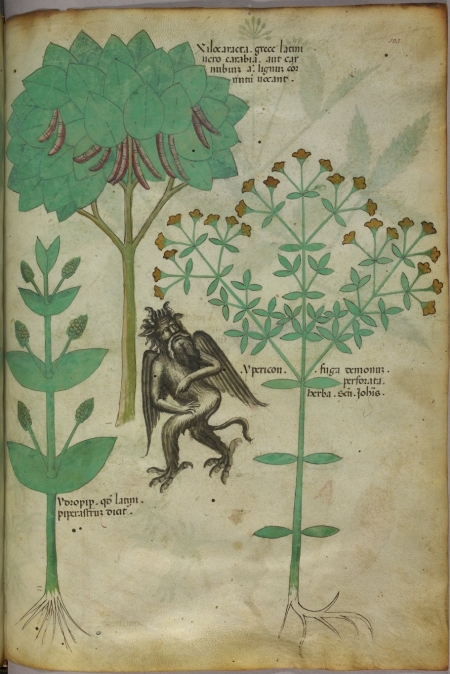



 Posted by lilithsapothecary
Posted by lilithsapothecary 




